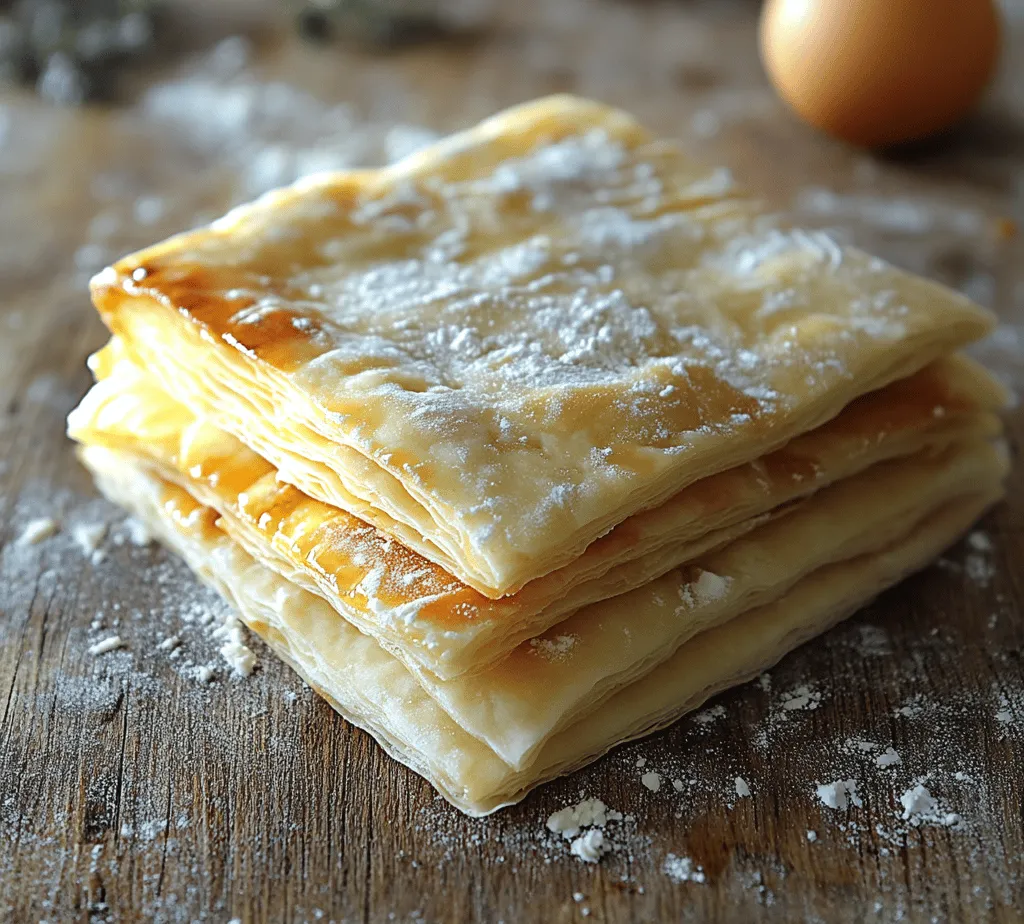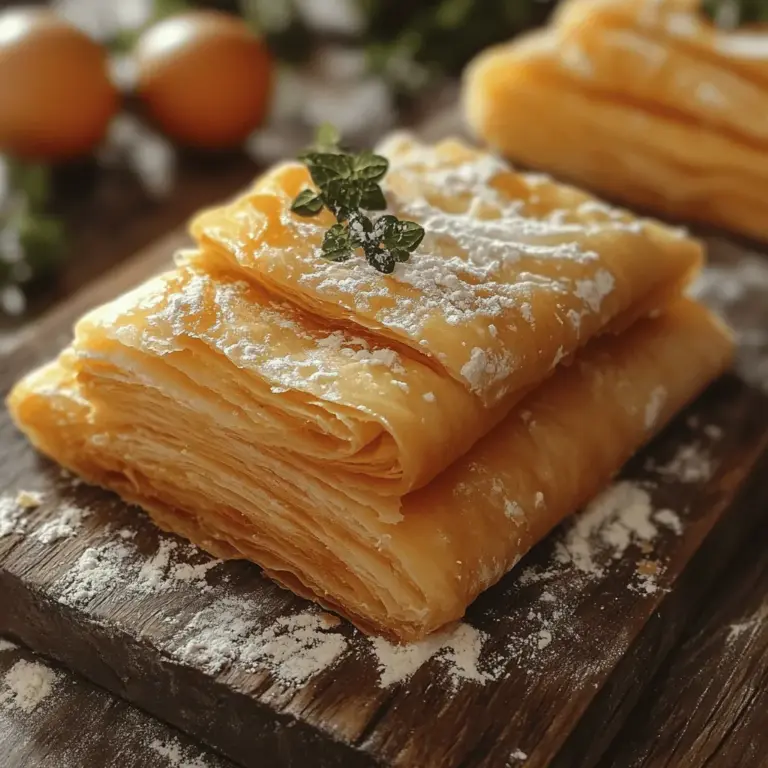Flaky Arabic dough is a cornerstone of Middle Eastern culinary tradition, revered for its light, airy texture and adaptability in a myriad of dishes. This dough is not just a staple; it serves as a canvas for a wide range of fillings, from savory meats and vegetables to sweet cheeses and fruits. Its versatility makes it a favorite among home cooks and professional bakers alike, who appreciate the delicate balance of flavors and textures that this dough can bring to a meal. Mastering flaky Arabic dough is essential for anyone looking to delve into the rich tapestry of Middle Eastern cooking, as it opens up a world of delectable pastries, pies, and filled options that can delight any palate.
Understanding Flaky Arabic Dough
Flaky Arabic dough is characterized by its unique texture, which results from a careful blend of flour, fat, and liquid. The dough is designed to be rolled out thinly, creating layers that will puff up during baking, giving it a light and flaky quality that is instantly recognizable. Unlike other types of dough, flaky Arabic dough achieves its distinct structure through the incorporation of cold fat, which creates pockets of air as the dough bakes.
Historically, this dough has deep cultural roots in the Middle East, where it has been used for centuries to create traditional dishes such as samosas, fatayer, and baklava. Each region boasts its own variations, showcasing the diversity and richness of Middle Eastern cuisine. The art of making this dough has been passed down through generations, embodying both family traditions and regional flavors.
When compared to other types of dough, such as puff pastry or shortcrust, flaky Arabic dough stands out for its balance of elasticity and flakiness. Puff pastry is renowned for its lofty layers and buttery richness, but it requires a more complex technique involving multiple folds and turns. Shortcrust, on the other hand, is known for its crumbly texture and is often used for sweet and savory tarts. Flaky Arabic dough strikes a middle ground, providing a satisfying bite and a flaky texture without the extensive labor of puff pastry.
Ingredients Breakdown
Creating the perfect flaky Arabic dough requires a precise selection of ingredients, each playing a crucial role in achieving the desired taste and texture. Here’s a closer look at what you’ll need:
All-Purpose Flour
All-purpose flour serves as the foundation of the dough, providing structure and stability. Its moderate protein content allows for the creation of gluten, which is essential for the dough’s elasticity. Using high-quality flour is key; it ensures that the dough can hold its shape while still being tender and flaky.
Salt
Salt is more than just a seasoning; it enhances the overall flavor of the dough. A small amount of salt helps to balance the sweetness of any fillings and brings out the natural flavors of the flour and butter. It’s important not to skip this ingredient, as it plays a vital role in the overall taste of the finished product.
Sugar
While not always a prominent flavor in savory dishes, sugar plays a significant role in the dough. It contributes to browning during baking, resulting in a beautifully golden crust. Additionally, sugar adds a subtle sweetness that can complement savory fillings or enhance sweet pastries.
Unsalted Butter
The choice of fat is critical when making flaky Arabic dough. Unsalted butter is preferred to control the salt content, allowing for more precise flavoring. The butter should be chilled and cubed before incorporation into the dough. Chilled butter creates distinct layers as it melts during baking, producing a tender and flaky texture.
Ice-Cold Water and Vinegar
Water is essential for bringing the dough together, but the temperature is equally important. Ice-cold water helps to keep the fat from melting too quickly, ensuring that those flaky layers develop properly. Adding a splash of vinegar (or lemon juice) can enhance the dough’s texture by inhibiting gluten formation, resulting in a more tender final product.
Extra Flour for Dusting
When rolling out the dough, extra flour is crucial to prevent sticking. It allows for easy manipulation of the dough without compromising its structure. Always have extra flour on hand to ensure a smooth rolling process.
Egg Wash (Optional)
While an egg wash is optional, it can significantly enhance the appearance of the baked goods. Brushing the surface of the dough with a beaten egg creates a shiny, golden crust that is visually appealing. This step is particularly beneficial for pastries that will be served at gatherings or special occasions.
Step-by-Step Guide to Making Flaky Arabic Dough
Creating flaky Arabic dough may seem daunting at first, but breaking it down into manageable steps makes the process straightforward and enjoyable. Below are the initial steps involved in making this delectable dough:
Combining Dry Ingredients
Start by measuring out your all-purpose flour, salt, and sugar into a large mixing bowl. It’s essential to thoroughly mix these dry ingredients together before adding any fat. This ensures even distribution of salt and sugar throughout the flour, leading to consistent flavor and texture in your dough. Use a whisk or fork to gently combine the ingredients, breaking up any clumps of flour.
Cutting in the Butter
Once the dry ingredients are well mixed, it’s time to incorporate the chilled, cubed butter. The goal here is to cut the butter into the flour mixture without completely blending it. This can be done using a pastry cutter, a fork, or even your hands. The key is to work quickly to keep the butter cold and to achieve a texture resembling coarse crumbs. You should see small pieces of butter mixed throughout the flour; these will create steam pockets during baking, leading to that coveted flaky texture.
Tools That Can Be Used
Choosing the right tool for cutting in the butter can make a difference. A pastry cutter is an excellent choice for achieving a uniform texture, but using your hands allows you to feel the dough’s consistency. If using your hands, work quickly and gently to avoid warming the butter too much. Alternatively, you can pulse the mixture in a food processor for a quick and efficient method.
Adding Wet Ingredients
Next, it’s time to bring your dough together with the wet ingredients. Gradually add the ice-cold water and vinegar mixture to the flour and butter mixture. Use a fork or your hands to gently mix until the dough begins to come together. Be cautious not to overwork the dough, as this can develop gluten and result in a tougher texture. The dough should be slightly crumbly but hold together when pinched. If it feels too dry, you can add a little more ice-cold water, one tablespoon at a time, until the desired consistency is reached.
By following these initial steps, you lay the foundation for a successful flaky Arabic dough that can be transformed into a variety of delicious dishes. This dough is not just about following a recipe; it’s about understanding the ingredients and techniques that will elevate your cooking and baking skills. As you progress through the recipe, you’ll find that the art of making flaky Arabic dough is as rewarding as the final product it yields.

Kneading the Dough
Kneading is a crucial step in the preparation of flaky Arabic dough. This process not only helps to evenly distribute the ingredients but also develops the gluten structure, which contributes to the dough’s overall texture. The key here is to knead just enough to bring the dough together without overworking it. Over-kneading can lead to a tough texture, resulting in a dough that is far from flaky.
To knead properly, start by turning your dough out onto a lightly floured surface. Use the heel of your palm to push the dough away from you, then fold it back over itself. Repeat this process, turning the dough a quarter turn after each push. Aim for about five to seven minutes of kneading, until the dough is smooth and elastic but still soft and pliable.
Forming the Dough
Once you have kneaded the dough, it’s time to form it into a ball. This stage is essential for achieving the right consistency, but an equally important step is allowing the dough to rest. Wrap the formed dough in plastic wrap or place it in an airtight container, and then refrigerate it for at least 30 minutes.
Resting the dough in the fridge allows the gluten to relax, making it easier to roll out later. This step is critical for achieving that delicate, flaky texture that makes Arabic dough so beloved. The cool temperature also helps to maintain the integrity of the fats in the dough, which is vital for flakiness.
Rolling Out the Dough
After resting, remove the dough from the fridge. Now it’s time to roll it out to your desired thickness. When rolling the dough, it’s important to maintain an even thickness throughout. Use a rolling pin and apply gentle, even pressure. Start from the center and roll outward to ensure uniformity.
Aim for a thickness of about 1/8 inch for most applications, but this can vary depending on what you’re making. It’s beneficial to frequently lift and turn the dough while rolling to prevent it from sticking to the surface. If you find it sticking, dust lightly with flour, but avoid using too much, as this can affect the texture.
Folding for Flakiness
The folding technique is what sets flaky Arabic dough apart from other types of dough. Once you have rolled the dough out, you will want to fold it multiple times to create layers. This is similar to making puff pastry. After rolling it out to your desired thickness, fold the dough into thirds, like a letter.
After folding, roll it out again. Repeat this process two or three times. Each fold creates additional layers, and when baked, these layers will separate, resulting in a beautifully flaky texture. The key to successful folding is to ensure that each layer is well-buttered (or oiled, depending on your recipe) to enhance the flakiness.
Chilling Again
After folding the dough, it’s essential to chill it once more before using it. This final chill helps to stabilize the layers and ensures that the fats remain solid. If the dough gets too warm, the butter or fat may melt, which could lead to a greasy texture instead of the sought-after flakiness.
Wrap the folded dough tightly in plastic wrap and refrigerate for another 30 minutes. This step is non-negotiable for achieving that perfect flaky consistency.
Using the Dough
Flaky Arabic dough is incredibly versatile and can be used in a variety of applications. Whether you’re making savory pastries like meat pies or sweet treats filled with fruit or nuts, this dough is adaptable to many culinary creations.
Some popular uses include:
– Pastries: Stuff the dough with your choice of savory or sweet fillings and bake for a delightful treat.
– Savory Dishes: Use the dough as a base for pies or tarts filled with vegetables, meats, or cheeses.
– Pies: Create delicious desserts by filling with seasonal fruits and baking until golden and flaky.
For an added touch of richness and color, consider applying an egg wash (a mixture of beaten egg and water) to the surface of your dough before baking. This will enhance the golden-brown color and add a subtle shine, elevating the appearance of your final product.
Common Mistakes to Avoid
While preparing flaky Arabic dough can be straightforward, there are common pitfalls to avoid to ensure the best results:
1. Overworking the Dough: Kneading or rolling too much can develop excess gluten, resulting in a tough rather than flaky texture. Stick to the recommended kneading times and be gentle when rolling.
2. Not Chilling the Dough: Skipping the chilling steps can lead to dough that is difficult to roll out and lacks the desired flakiness. Always make time for those chilling periods.
3. Improper Ingredient Measurements: Baking is a science, and precise measurements are crucial. Use a kitchen scale or measuring cups for accuracy, especially when it comes to flour and fats.
Variations and Creative Uses for Flaky Arabic Dough
Flaky Arabic dough can be adapted for a variety of delightful dishes beyond the traditional uses:
– Sweet Applications: Transform this dough into a delicious dessert by filling it with chocolate, custard, or seasonal fruits for pastries that are sure to impress. Consider adding spices like cinnamon or cardamom for a Middle Eastern twist.
– Savory Options: Use the dough for main dishes such as stuffed pastries or savory tarts filled with ingredients like spinach and feta cheese or spiced ground lamb.
– Cultural Variations: Different regions may adapt this dough recipe to suit local tastes. For instance, in some cultures, it may be used in dishes that incorporate spices unique to that area, adding a personal touch to the classic recipe.
Conclusion
Mastering flaky Arabic dough opens up a world of culinary possibilities. This dough’s versatility allows you to create an array of dishes, from savory pastries to sweet desserts, all with that delightful flaky texture that is so satisfying.
By following the steps outlined—kneading gently, allowing for proper resting, rolling with care, and utilizing folding techniques—you will be well on your way to creating perfect dough every time. The importance of chilling cannot be overstated, as it plays a crucial role in achieving that sought-after flakiness.
As you experiment with this dough, don’t hesitate to get creative with fillings and applications. Whether you’re making a comforting meat pie or a decadent fruit tart, the flaky Arabic dough will elevate your cooking and baking endeavors. Enjoy the satisfying experience of mastering this fundamental recipe and have fun exploring its many culinary possibilities.

